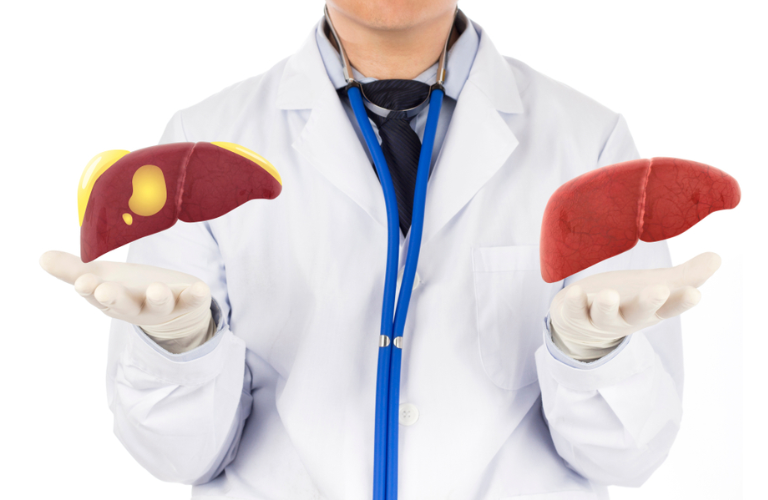Fatty liver disease: Causes, Symptoms, and Treatment options
Fatty liver disease, also known as hepatic steatosis, is a condition in which fat accumulates in the liver, leading to inflammation and damage. The two types of fatty liver diseases are non-alcoholic fatty liver disease (NAFLD) and alcoholic fatty liver disease (AFLD).
Causes:
● Non Alcoholic Fatty Liver Disease: The exact cause of NAFLD is unknown, but it is believed to be linked to obesity, type 2 diabetes, insulin resistance, high cholesterol or triglycerides, and metabolic syndrome.
● Alcoholic fatty liver disease: Excessive alcohol consumption causes Alcoholic fatty liver disease
Symptoms:
● NAFLD: Often has no symptoms in the early stages, but as the condition progresses, it can cause fatigue, weakness, abdominal pain, and yellowing of the skin and eyes (jaundice).
● AFLD: Symptoms can include abdominal pain, nausea, vomiting, fatigue, and yellowing of the skin and eyes (jaundice).
Treatment:
● Lifestyle changes: For NAFLD, lifestyle changes such as losing weight, increasing physical activity, and eating a healthy diet can help reduce the amount of fat in the liver and improve liver function. For AFLD, it is important to stop drinking alcohol to prevent further damage to the liver.
● Medications: There is no specific medication for fatty liver disease, but a Best Liver Doctor in Surat may prescribe medications to treat related conditions, such as diabetes or high cholesterol, or to manage symptoms.
● Monitoring: Regular monitoring of liver function and imaging tests may be necessary to track the progression of the disease and evaluate the effectiveness of treatment.
● In severe cases the expert liver surgeon In Surat may suggest a liver transplant.
FAQ:
What is the main cause of a fatty liver?
It is important to consult a liver doctor if you have symptoms of fatty liver disease or if you have risk factors for the condition. If diagnosed and treated early it will be easier to help prevent complications and improve outcomes
The main cause of a fatty liver is the accumulation of fat in the liver cells. In nonalcoholic fatty liver disease (NAFLD), which is the most common type of fatty liver disease, this accumulation is typically caused by an unhealthy diet, sedentary lifestyle, and obesity. When the liver cannot break down fat at a normal rate, excess fat accumulates in liver cells, leading to inflammation and damage. Other risk factors for NAFLD include insulin resistance, type 2 diabetes, high cholesterol, and metabolic syndrome.
What is the best treatment for a fatty liver?
In many cases, the most effective approach is to address the risk factors that contribute to the development of fatty liver disease, such as obesity, diabetes, high cholesterol, and high blood pressure.
Nonalcoholic fatty liver disease (NAFLD) is more common and occurs in people who do not consume excessive amounts of alcohol. The exact cause of NAFLD is not fully understood, but risk factors include obesity, type 2 diabetes, high cholesterol, and metabolic syndrome. Other factors, such as rapid weight loss, certain medications, and viral hepatitis, can also contribute to the development of NAFLD.
Alcoholic fatty liver disease, on the other hand, is caused by excessive alcohol consumption. When the liver is unable to metabolize the alcohol, it can lead to the buildup of fat in the liver cells.
What is the cause and treatment of fatty liver?
The treatment for fatty liver disease depends on the underlying cause. For nonalcoholic fatty liver disease, the following measures may be helpful:
- Lifestyle changes: Losing weight, consumption of healthy diet, and increasing physical activity can help improve NAFLD.
- Medications: Certain medications, such as vitamin E and pioglitazone, may be used to treat NAFLD.
- Management of underlying conditions: Treating underlying conditions such as diabetes, high cholesterol, and high blood pressure can help reduce the risk of NAFLD or reverse it.
- Avoiding alcohol and drugs: For people with alcoholic fatty liver disease, avoiding alcohol and certain drugs can help prevent further damage to the liver.
In some cases, more advanced forms of NAFLD may require additional interventions, such as liver biopsy or surgery.
What are the 3 most common causes of fatty liver disease?
The three most common causes of fatty liver disease are:
- Obesity: Obesity is a significant risk factor for fatty liver disease, as excess body weight can lead to an accumulation of fat in the liver.
- Type 2 Diabetes: People with type 2 diabetes are more likely to develop fatty liver disease because insulin resistance can cause fat to build up in the liver.
- Alcohol consumption: Heavy alcohol consumption can cause alcoholic fatty liver disease, which is a type of fatty liver disease that occurs due to excessive alcohol consumption.

Comments
Post a Comment